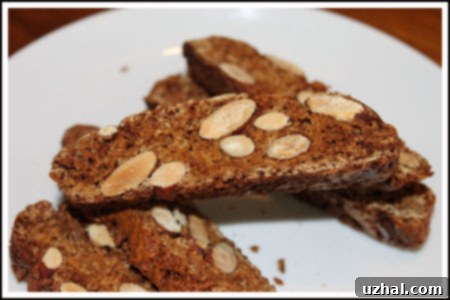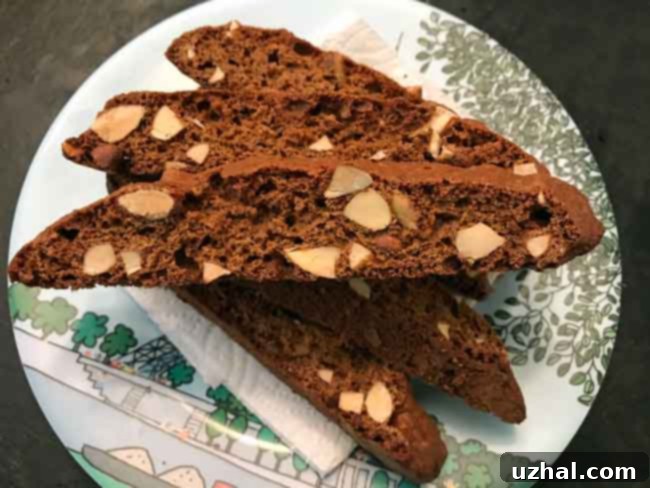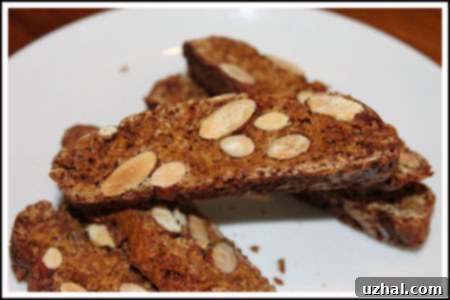Irresistible Small Batch Coconut Sugar Almond Biscotti: A Timeless Recipe
There’s something incredibly satisfying about baking a batch of homemade biscotti. These twice-baked Italian cookies, known for their delightful crunch and ability to perfectly complement a warm beverage, have been a staple in kitchens for centuries. Our Small Batch Almond Biscotti recipe, a beloved classic from 2010, brings all the traditional charm with a unique twist: the deep, rich flavor of coconut sugar. This recipe is designed for the home baker who craves that authentic biscotti experience without needing to make a monumental quantity, ensuring every piece is fresh and flavorful. Whether you’re a seasoned baker or just starting, this guide will walk you through creating biscotti that are crispy, nutty, and utterly delicious.

The Flour Journey: From Whole Grain to All-Purpose Perfection
When this recipe for Almond Biscotti first came to life in 2010, it proudly featured whole grain flour. Specifically, I used a product called “Eagle Mills Whole Grain All-Purpose” flour, which was quite remarkable because it offered the nutritional benefits of whole grain without compromising on the taste or texture often associated with all-purpose flour. Unfortunately, that particular flour seems to have vanished from the market, leaving many bakers, including myself, to seek out suitable alternatives.
For a time, the closest substitute I found was white whole wheat flour. This option provides the whole grain goodness while being milder in flavor and lighter in texture than traditional whole wheat flour, making it a decent compromise. However, after countless batches and many family taste tests, a clear preference emerged. The consensus, shared by everyone in the household, was that the version made with standard all-purpose flour simply yielded the best biscotti. The all-purpose flour creates a slightly lighter, more tender crumb (before the second bake) and a consistently crispier final texture that is universally adored. While I still appreciate the nutritional value of whole grains, for the ultimate biscotti experience that everyone raves about, all-purpose flour has become the go-to choice for this recipe.
The Unmistakable Charm of Coconut Sugar
While the flour choice has evolved over the years, one ingredient remains absolutely non-negotiable in this Almond Biscotti recipe: coconut sugar. This natural sweetener is truly the star of the show, imparting a unique and incredibly appealing flavor profile that sets these biscotti apart. Unlike regular granulated sugar, coconut sugar brings a depth of flavor that is often described as a rich, burnt caramel. This distinctive note harmonizes beautifully with the nutty crunch of the almonds, creating a sophisticated and irresistible taste experience.
Beyond its exceptional flavor, coconut sugar also offers a slightly lower glycemic index compared to conventional sugars, which can be an attractive benefit for some. But honestly, it’s the taste that makes it indispensable here. It doesn’t just provide sweetness; it adds a layer of complexity and warmth that permeates every bite of the biscotti. You’ll find yourself reaching for another, not just for the crisp texture, but for that lingering, delicious caramel undertone. Trust us, once you try biscotti made with coconut sugar, you won’t want to go back to any other sweetener for this recipe.
Almonds: The Perfect Nutty Companion
What would almond biscotti be without, well, almonds? These wonderful nuts are not just an add-in; they are an integral part of the biscotti’s character. In this recipe, we use roasted unsalted almonds, which provide a fantastic textural contrast and a rich, buttery flavor that complements the coconut sugar beautifully. Roasting the almonds beforehand, even if they are pre-roasted, helps to intensify their nutty essence and brings out their natural oils, making them even more fragrant and delicious when baked into the dough.
The generous ¾ cup of almonds ensures that almost every slice of biscotti has a delightful crunch from the nuts. Their presence contributes to the overall robust structure of the biscotti, making them sturdy enough for dipping without being overly hard. If you’re feeling adventurous, you can lightly toast raw almonds in a dry pan or on a baking sheet at a low temperature for about 5-7 minutes before adding them to the dough. This extra step can further enhance their flavor, bringing out their deep, roasted notes which pair exceptionally well with the caramel hints from the coconut sugar.
Understanding the Unique Texture of These Biscotti
When it comes to biscotti, texture is paramount. Some biscotti recipes call for butter or oil to achieve a softer, more cookie-like crumb. However, this Small Batch Almond Biscotti deliberately omits these fats. This absence is key to achieving its characteristic crispness and firmness. You might find that the texture is harder than some other biscotti you’ve encountered, but let me assure you, it’s designed that way for a reason.
This firmness is what makes it the perfect candidate for dipping. Whether it’s into a steaming mug of coffee, a comforting cup of tea, or even a glass of vin santo, these biscotti are built to withstand a good dunk without falling apart. Yet, they are not so hard that you’ll need to worry about your teeth. The double-baking process ensures they are thoroughly crisp throughout, offering a satisfying snap with every bite, even when enjoyed straight. It’s a texture that speaks to tradition, designed to last and to be savored, making each piece a delightful experience on its own or as a companion to your favorite beverage.

Why Choose a Small Batch Biscotti Recipe?
In a world of supersized recipes, there’s a comforting charm in a “small batch.” This recipe is specifically designed to yield about 12-15 perfectly sized biscotti, plus a few “stubby ends” that are perfect for immediate sampling (baker’s privilege!). This quantity is ideal for several reasons. Firstly, it prevents overwhelming your kitchen with dozens of cookies, making it perfect for smaller households or when you simply want to satisfy a craving without committing to a massive baking project.
Secondly, a small batch ensures maximum freshness. Biscotti are best enjoyed when they are crisp and fragrant, and a smaller yield means you’re more likely to finish them within their peak freshness window. It also encourages more frequent baking, allowing you to enjoy the wonderful aroma of baking biscotti more often. Whether you’re making them for a quiet morning coffee, an afternoon tea break, or as a thoughtful homemade gift, the small batch approach makes baking biscotti a manageable and enjoyable endeavor, rather than a daunting task. It’s all about quality over quantity, delivering a fresh, delicious experience every time.
The Recipe: Small Batch Coconut Sugar Almond Biscotti
This recipe balances tradition with modern pantry staples, focusing on rich flavor and satisfying crunch. Get ready to create a truly memorable treat.
Ingredients:
- 1 ⅓ cups (170 grams) All-Purpose Flour: Spoon and sweep method is recommended for accurate measurement. While the original recipe used whole grain, all-purpose provides the best texture as per family preference. If you prefer a whole grain option, white whole wheat flour is a good substitute. A mix of both can also be experimented with.
- ⅔ cup (80 grams) Coconut Palm Sugar: Essential for that distinct burnt caramel flavor that makes this biscotti special. Do not substitute with regular granulated sugar if you want the signature taste.
- ¾ teaspoon (3.75 ml) Baking Soda: Provides a slight lift and contributes to the texture.
- ¼ teaspoon (1.25 ml) Salt: Balances the sweetness and enhances all the flavors.
- 2 Large Eggs: Act as the primary binder, giving structure to the dough.
- ¾ teaspoon (3.75 ml) Pure Vanilla Extract: Adds a warm, aromatic note that complements the almonds and coconut sugar.
- ¾ cups (60 grams) Roasted Unsalted Almonds: For crunch and nutty flavor. Ensure they are roasted for optimal taste; you can lightly toast them yourself if they are raw.
Step-by-Step Instructions:
1. Prepare Your Oven and Baking Sheet: Begin by preheating your oven to 300 degrees F (150 degrees C). This lower temperature is crucial for the slow, even baking that gives biscotti its unique texture. Line a standard cookie sheet with parchment paper or non-stick foil. This prevents sticking and makes transferring the baked log much easier.
2. Combine Dry Ingredients: In a large mixing bowl, thoroughly whisk together the all-purpose flour, coconut sugar, baking soda, and salt. Make sure there are no clumps and that the ingredients are evenly distributed. Set this bowl aside.
3. Prepare Wet Ingredients: In a separate, medium-sized bowl, use an electric mixer or a sturdy whisk to beat the two large eggs until they become light, frothy, and slightly pale. This aeration is important for the biscotti’s internal structure. Beat in the pure vanilla extract until just combined.
4. Mix Dough: Pour the wet ingredients into the dry ingredients. Using a sturdy spoon or a rubber spatula, mix by hand until just combined. The dough will be quite heavy and noticeably sticky. Avoid overmixing; mix only until no dry streaks of flour remain.
5. Incorporate Almonds: Add the roasted unsalted almonds to the dough. Using your hands (which can be lightly floured or slightly wet to prevent sticking), knead the nuts into the dough until they are evenly distributed throughout. The dough will be thick and might seem crumbly initially, especially depending on your flour and how precisely you measured, but it should come together and hold its shape with a bit of kneading.
6. Shape the Log: Lightly wet your hands – this is a crucial tip for handling sticky dough! Shape the dough into a log approximately 9 inches (23 cm) long and 2 ½ inches (6-7 cm) wide. Place this log carefully onto the prepared baking sheet.
7. First Bake (The “Bake” of Biscotti): Bake the log in the preheated 300 degrees F (150 degrees C) oven for 50 minutes. During this first bake, the log will spread slightly and become golden brown on the outside. It will feel firm to the touch. Remove the log from the oven but remember to leave the oven on for the second bake!
8. Cool and Slice: Let the baked log cool on the baking sheet for about 5 minutes. This brief cooling period helps it firm up slightly, making it easier to slice without crumbling. Carefully transfer the warm log to a large cutting board. Using a sharp, serrated knife, cut the log into ½ to ¾ inch (1.25 to 2 cm) thick slices on the diagonal. The serrated knife is essential for a clean cut through the crust and nuts.
9. Second Bake (The “Bake Again” of Biscotti): Arrange the sliced biscotti pieces back onto the baking sheet, cut sides facing up. Return them to the 300 degrees F (150 degrees C) oven and bake for another 30 minutes. If you sliced your biscotti particularly thinly (½ inch or less), start checking them around 20 minutes. You want them golden brown and thoroughly crisp. The exact time may vary slightly depending on your oven and slice thickness. Once baked, remove them from the oven.
10. Cool Completely: Transfer the finished biscotti to a wire rack to cool completely. They will crisp up further as they cool. This recipe yields approximately 12-15 beautiful biscotti, plus those irresistible stubby ends perfect for the chef’s tasting!
Tips for Perfect Biscotti Every Time
- Don’t Overmix: When combining wet and dry ingredients, mix just until the flour streaks disappear. Overmixing can develop the gluten too much, leading to tougher biscotti.
- Wet Hands for Shaping: This simple trick makes shaping the sticky dough log much easier and prevents frustration.
- Use a Serrated Knife: For clean, even slices, especially after the first bake, a sharp serrated knife is your best friend. It glides through the crust and nuts without tearing the biscotti.
- Monitor the Second Bake: Keep a close eye on your biscotti during the second bake. They can go from perfectly golden to overly brown quickly. The goal is crispness, not burning.
- Even Thickness: Try to slice your biscotti to a consistent thickness for even baking during the second round.
- Patience is Key: Allow the biscotti to cool completely on a wire rack. This step is crucial for them to achieve their ultimate crispness.
Serving Suggestions for Your Homemade Biscotti
These Small Batch Coconut Sugar Almond Biscotti are wonderfully versatile and pair beautifully with a variety of beverages and desserts. Their sturdy, crisp texture makes them ideal for dipping:
- Coffee & Espresso: The classic pairing! The bitter notes of coffee perfectly complement the sweet, caramel flavor of the biscotti.
- Tea: A soothing cup of black or herbal tea is an excellent companion, offering a gentler contrast.
- Hot Chocolate: For a truly indulgent treat, dip your biscotti into a rich, creamy hot chocolate.
- Dessert Wine: In Italy, biscotti are often served with Vin Santo, a sweet dessert wine. The wine softens the biscotti and releases its flavors beautifully.
- Ice Cream: Crumble a few pieces over a scoop of vanilla or coffee ice cream for added texture and flavor.
- On Their Own: Sometimes, the simple pleasure of a crisp biscotti enjoyed plain is all you need.
Storing Your Almond Biscotti
Proper storage is essential to maintain the crispness and freshness of your homemade biscotti. Once completely cooled, store the biscotti in an airtight container at room temperature. They will remain fresh and delightfully crisp for up to 2-3 weeks. Avoid refrigeration, as this can make them soft. For longer storage, you can freeze baked biscotti in an airtight container for up to 3 months. Thaw at room temperature before serving.
Variations to Explore
While this classic recipe is perfect as is, you can certainly experiment with variations to suit your taste:
- Citrus Zest: Add 1-2 teaspoons of orange or lemon zest to the dry ingredients for a bright, aromatic twist.
- Spices: A pinch of cinnamon, nutmeg, or cardamom can add warmth and complexity.
- Chocolate Drizzle: Melt some dark or white chocolate and drizzle it over the cooled biscotti for an extra touch of indulgence.
- Other Nuts: While almonds are traditional, feel free to try pecans, walnuts, or hazelnuts for a different nutty flavor.
- Dried Fruit: Incorporate finely chopped dried cranberries, cherries, or apricots into the dough for added chewiness and flavor.
We hope you enjoy baking and savoring these delightful Small Batch Coconut Sugar Almond Biscotti as much as we do. It’s a recipe that has stood the test of time in our kitchen, adapted and perfected to bring you the very best. The combination of the unique burnt caramel notes from the coconut sugar, the satisfying crunch of roasted almonds, and the perfectly crisp texture makes these biscotti truly special. So go ahead, preheat your oven, gather your ingredients, and let the inviting aroma of baking biscotti fill your home. Don’t forget to share your creations and experiences with us!
